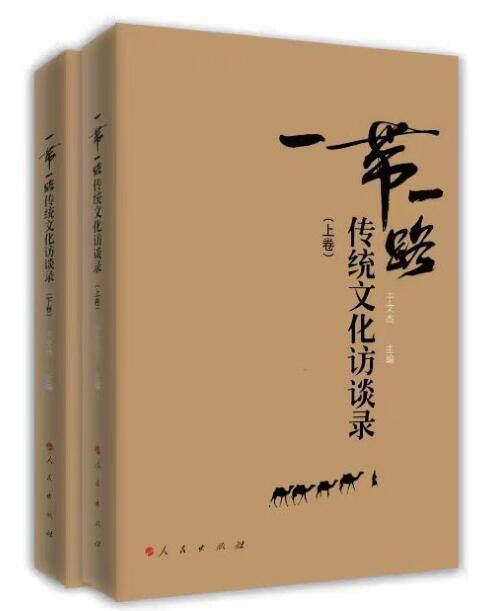Traditional Chinese Crafts in the Context of Silk Road Civilization -- Interview with Master Li Maodi, a Master of Zhuoni Tao Inkstone Making in Gansu’s Zhuoni
2024-05-14ByLiMaodiandYuWenjie
By Li Maodi and Yu Wenjie


Record of Traditional Culture Interviews Along the Belt and Road
Yu Wenjie
Peoples Publishing House
January 2021
198.00 (CNY)
Yu Wenjie
Yu Wenjie is a Doctor of Literature, a postdoctoral fellow in History, a professor at the School of History, and a doctoral supervisor at Nanjing University. He has visited and lectured at world-renowned universities and research institutions such as Oxford University, University of London, and University of York.
Professor Yu Wenjie: Master Li Maodi, the birth of Tao inkstones is closely linked to their geographical and historical context. We would like to know what intellectual resources and cultural nourishment the Tao River culture provided to the formation and development of Tao inkstones. Also, in recent years, the internationalization of ethnic crafts has become a new trend. We are curious about what new thoughts this modern living background has brought to you.
Master Li Maodi: Todays “Belt and Road” is a continuation and development of the ancient Silk Road. From the historical development of the ancient Silk Road, we can derive how todays “Belt and Road” should be understood and developed. We know that the “Belt and Road” is a route of economic and cultural exchange. Tao inkstone carving, as a national intangible cultural heritage, deserves our diligent protection, inheritance, and development.
Gansu is located at the strategic throat of the ancient terrestrial Silk Road, where multiple cultures have merged and collided since ancient times. The Tao River is an important tributary of the upper Yellow River, originating from the eastern slopes of the Xiqing Mountains in Qinghai, and flowing into Gansu at the eastern slopes of the Xiqing Mountains in Luqu County, making it one of the five major water systems in Gansu. Although the Gannan region is economically underdeveloped, it is enriched with unique cultural resources. The main channel of the Tao River is about 600 kilometers long, covering an area of more than 250,000 square kilometers, making it an extremely important water resource for Gansu Province. At the same time, the Tao River basin is also one of the origins of human civilization, where brilliant ancient civilizations such as the Majiayao and Siwa cultures were discovered, dating back over 5,000 years.
Tao River inkstones, commonly known as “Tao inkstones,” are named after the Tao River and have a long history. Tao inkstones originated during the Tang Dynasty, became famous during the Song Dynasty, and are one of the four types of famous inkstones in China, alongside Guangdongs Duan inkstones, Anhuis She inkstones, and Shanxis Chengni inkstones.
The Minzhou region has been a place of magic, mystery, and sanctity since ancient times. Here, the Tibetan Plateau and the Loess Plateau meet naturally, and various ethnicities and religions, such as Taoism, Han Buddhism, Tibetan Buddhism, and Islam, encounter each other. Here, numerous relics of prehistoric Chinese civilization are found, especially sites like the Xizhai Sanzuwan, Qingshui Dalu Village, and Shili Zhangjiaping. Here, countless traces of civilization are evident, where diverse cultural fragments are not only rich and comprehensive but also extremely exquisite and refined, representing a distinctive source of the prehistoric Yellow River civilization — the Tao River basin civilization. Here, various cultures meet, recognize, and integrate, respecting rather than excluding one another. Here, an open and tolerant mindset exists among different cultural entities, characterized by harmony without uniformity. The “Belt and Road” initiative is rooted in history and culture, and Tao inkstone carving is precisely the product of multi-ethnic cultural exchange and integration along the Silk Road in the Gannan region. Therefore, the inheritance, development, and innovation of Tao inkstone carving, a national intangible cultural heritage, require both the perseverance and innovation of traditional culture and the wide attention, support, and effort of the public.
Professor Yu Wenjie: Tao inkstones are among the most representative stone inkstones in China. Master Li Maodi, could you share the historical origins of Tao inkstones as stone inkstones?
Master Li Maodi: Tao inkstones are made from Tao River greenstone, formally known as Tao River greenstone inkstones. This stone is characterized by its tough yet delicate texture, clear patterns, and glossy appearance. They are mostly found along the middle reaches of the Tao River and in the canyons near Lama Cliff. Inkstones made from Tao River stone are prized for their elegant green color, jade-like luster, quick ink production without damaging the brush, and the ability to store ink for a long time without drying out or rotting, making them cherished by scholars throughout the ages.
Physical evidence shows that before being used to make inkstones, Tao River stones served as grinding tools, roughly from the Neolithic Age to the middle and late Western Han Dynasty. Additionally, many scholars and poets writings reveal that early Tao River stones were also used as whetstones, which are stones used for sharpening knives and swords, similar in function to grinding tools. Archaeological finds and historical documents have confirmed that the carving of Tao inkstones began in the Tang Dynasty.
During the early Tang Dynasty, the production of inkstone platforms was entirely utilitarian, with most being square or rectangular and plain without any decorations. The “Four Famous Inkstones” emerged during the mid-Tang Dynasty. Before this, ceramic inkstones were most commonly used, but they still focused on practicality. However, as Duan, She, Tao, and Chengni inkstones appeared, scholars began to appreciate the beauty of the inkstone material itself, in addition to its practicality. By this time, Tao inkstones were already considered among the famous inkstones, indicating a certain scale of production, though they were not as widely used as Duan and She inkstones. There are few surviving Tang Dynasty Tao inkstones today, and information about them is scarce, scattered in a few poems. The only known Tang Dynasty Tao inkstone is a scoop-shaped stone inkstone. Despite its ancient age, its characteristics are significant, embodying the basic features of Tao inkstones. Experts have identified this inkstone as belonging to the late Tang or Five Dynasties period. This not only confirms the existence of Tang Dynasty Tao inkstones, correcting the misconception that Tao inkstones originated in the Song Dynasty, but also further supports the assertion that Tao inkstones date back to the Tang Dynasty.
Compared to other historical periods, the Song Dynasty was relatively stable and had a highly developed economy. The craftsmanship and art of the Song Dynasty, building on the Sui, Tang, and Five Dynasties, saw significant advancement, especially with the unprecedented flourishing of court culture, greatly increasing scholars enthusiasm for stationery. The “Four Treasures of the Study” played an extremely important role in the Song Dynasty as special artistic and craft carriers. The Song Dynasty marked the first peak in the development of Tao inkstones. Compared to the Tang Dynasty, Song Dynasty Tao inkstones began to emphasize decoration, with carving techniques becoming more exquisite, patterns richer, and themes more varied, especially focusing on human subjects. Since people in the Song Dynasty sat on the floor to accommodate easier use, the “hand-warmer inkstone” became a popular form at the time. Besides rectangular hand-warmer inkstones, other shapes also appeared, such as natural-shaped inkstones and oval high-platform inkstones. At this time, the function of Tao inkstones also diversified, being used not only for grinding ink by scholars and poets but also for appreciation, collection, and gifts to relatives and friends. The love and research of scholars and poets for Tao inkstones have increased over time, leaving behind many beautiful poems and records that praise Tao inkstones. Works such as Su Yijians “Four Treasures of the Study Inventory,” Mi Fus “History of Inkstones,” and Zhao Xihus “Record of Pure Enjoyment of the Cave Heavens” provide valuable textual materials and reliable factual bases for later generations to study Tao inkstones. The number of existing Song Dynasty Tao inkstones has increased compared to the Tang Dynasty, with examples like the “Orchid Pavilion Pact Inkstone,” “Mount Penglai Inkstone,” and “Yingzhen Crossing the Sea Inkstone” housed in the Palace Museum being notable examples.
The Yuan Dynasty saw frequent social turmoil and hardships in peoples lives, naturally affecting the pursuit of stationary items. During this period, Tao inkstone production was halted, only being offered as tribute to the court, with the annual production of inkstone platforms not exceeding a hundred during the Jin and Yuan periods. Hence, the Yuan Dynasty literary figure Yuan Haowen once wrote, “The county official had to spend six million yuan of the Yuan Dynasty currency every year to buy this inkstone that was transported from Lintao,” hinting at the scarcity of Tao River stone and how precious Tao inkstones were at the time. During this period, peoples sitting and lying habits gradually changed from sitting on the floor to sitting with their legs hanging down, leading to changes in writing habits. The design of inkstones became more varied, and Tao inkstones were also valued by emperors and generals for appreciation and collection. Under such circumstances, inkstone makers, aiming to cater to the aesthetic tastes of scholars and literati, had new requirements for design and carving techniques, leading to a generally rough, simple, and natural style in Yuan Dynasty inkstone carving.
During the Ming Dynasty, Duan inkstones, She inkstones, and Tao inkstones remained highly famous. However, due to the difficulty in mining and the scarcity of Tao River stone, producing a fine Tao inkstone was incredibly precious. At this time, Tao inkstones became even more diverse in form, building on the traditions of the Tang and Song dynasties with innovation and introducing new shapes. “feng風 (wind)” inkstones became very popular during the Ming and Qing periods, as evidenced by the paintings of literati. Besides traditional shapes, there appeared many inkstones that utilized the natural features of the stone, with the earliest matching-cover inkstones also emerging during this time. At this point, Tao inkstones, both in terms of design and carving techniques, pursued uniqueness and craftsmanship, featuring an elegant and atmospheric appearance as well as exquisite and delicate details. In terms of carving techniques, relief carving was predominantly used, supplemented by high relief and through-carving, or with fine and delicate lines outlining, making the inkstone surface vividly present objects with both form and spirit and a profound overall effect. Additionally, the themes became broader and the decorations more varied, involving dragons and phoenixes, auspicious symbols, flowers and birds, fish and insects, landscapes, figures, and allusions. Overall, the development of Tao inkstones during the Ming and Qing dynasties far exceeded that of previous generations, with a significantly greater number of exquisite Tao inkstones remaining from these periods compared to the Tang and Song dynasties. The prosperity of inkstone culture led to the emergence of successive research works on Tao inkstones, such as Gao Lians “Eight Notes on Following Life,” Dong Qichangs “Pure and Secret Records of Yunxuan,” and Tu Longs “Records of Long Things: Miscellaneous Matters on Inkstones,” which all contain discussions on Tao inkstones.
During the Republic of China period, there was a strong demand for Tao inkstones, leading to increased mining of Tao stone materials and severe waste of stone resources. By the late Republic of China period, the development of Tao inkstones had begun to take shape, with several major schools of carving techniques emerging in the inkstone-making community, including the Wang familys hollow carving, semi-circular carving, high relief, and matching-cover techniques, Xu familys lifelike dragon inkstone technique, and the Bao familys floral carving technique, which were very famous schools of art. At the beginning of the new China, Tao inkstone mining received attention from all sides. After the establishment of agricultural cooperatives, the right to mine stone was executed collectively, effectively controlling the indiscriminate mining of stone, and management of mining areas was put on the right track. In the 1980s, Zhuoni County established a specialized Tao inkstone craft processing factory, producing ethnic crafts primarily featuring Tao inkstones. Meanwhile, influenced by the Tao inkstone-making craze, villagers from surrounding villages also joined the inkstone-making ranks. Near the inkstone-making region, the number of family workshops engaging in Tao inkstone carving rapidly increased, with over 500 artisans, primarily Tibetan, involved in Tao inkstone production and nearly a hundred artisans involved in stone mining and inkstone transportation, creating a very prosperous scene.
